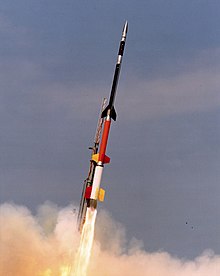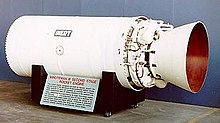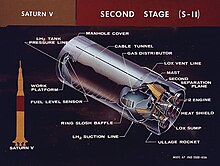
A | B | C | D | E | F | G | H | CH | I | J | K | L | M | N | O | P | Q | R | S | T | U | V | W | X | Y | Z | 0 | 1 | 2 | 3 | 4 | 5 | 6 | 7 | 8 | 9


A multistage rocket or step rocket[1] is a launch vehicle that uses two or more rocket stages, each of which contains its own engines and propellant. A tandem or serial stage is mounted on top of another stage; a parallel stage is attached alongside another stage. The result is effectively two or more rockets stacked on top of or attached next to each other. Two-stage rockets are quite common, but rockets with as many as five separate stages have been successfully launched.
By jettisoning stages when they run out of propellant, the mass of the remaining rocket is decreased. Each successive stage can also be optimized for its specific operating conditions, such as decreased atmospheric pressure at higher altitudes. This staging allows the thrust of the remaining stages to more easily accelerate the rocket to its final speed and height.
In serial or tandem staging schemes, the first stage is at the bottom and is usually the largest, the second stage and subsequent upper stages are above it, usually decreasing in size. In parallel staging schemes solid or liquid rocket boosters are used to assist with launch. These are sometimes referred to as "stage 0". In the typical case, the first-stage and booster engines fire to propel the entire rocket upwards. When the boosters run out of fuel, they are detached from the rest of the rocket (usually with some kind of small explosive charge or explosive bolts) and fall away. The first stage then burns to completion and falls off. This leaves a smaller rocket, with the second stage on the bottom, which then fires. Known in rocketry circles as staging, this process is repeated until the desired final velocity is achieved. In some cases with serial staging, the upper stage ignites before the separation—the interstage ring is designed with this in mind, and the thrust is used to help positively separate the two vehicles.
A multistage rocket is required to reach orbital speed. Single-stage-to-orbit designs are sought, but have not yet been demonstrated.
Performance




The reason multi-stage rockets are required is the limitation the laws of physics place on the maximum velocity achievable by a rocket of given fueled-to-dry mass ratio. This relation is given by the classical rocket equation:
where:
- is delta-v of the vehicle (change of velocity plus losses due to gravity and atmospheric drag);
- is the initial total (wet) mass, equal to final (dry) mass plus propellant;
- is the final (dry) mass, after the propellant is expended;
- is the effective exhaust velocity (determined by propellant, engine design and throttle condition);
- is the natural logarithm function.
The delta v required to reach low Earth orbit (or the required velocity of a sufficiently heavy suborbital payload) requires a wet to dry mass ratio larger than can realistically be achieved in a single rocket stage. The multistage rocket overcomes this limit by splitting the delta-v into fractions. As each lower stage drops off and the succeeding stage fires, the rest of the rocket is still traveling near the burnout speed. Each lower stage's dry mass includes the propellant in the upper stages, and each succeeding upper stage has reduced its dry mass by discarding the useless dry mass of the spent lower stages.[2]
A further advantage is that each stage can use a different type of rocket engine, each tuned for its particular operating conditions. Thus the lower-stage engines are designed for use at atmospheric pressure, while the upper stages can use engines suited to near vacuum conditions. Lower stages tend to require more structure than upper as they need to bear their own weight plus that of the stages above them. Optimizing the structure of each stage decreases the weight of the total vehicle and provides further advantage.
The advantage of staging comes at the cost of the lower stages lifting engines which are not yet being used, as well as making the entire rocket more complex and harder to build than a single stage. In addition, each staging event is a possible point of launch failure, due to separation failure, ignition failure, or stage collision. Nevertheless, the savings are so great that every rocket ever used to deliver a payload into orbit has had staging of some sort.
One of the most common measures of rocket efficiency is its specific impulse, which is defined as the thrust per flow rate (per second) of propellant consumption:[3]
- =
When rearranging the equation such that thrust is calculated as a result of the other factors, we have:
These equations show that a higher specific impulse means a more efficient rocket engine, capable of burning for longer periods of time. In terms of staging, the initial rocket stages usually have a lower specific impulse rating, trading efficiency for superior thrust in order to quickly push the rocket into higher altitudes. Later stages of the rocket usually have a higher specific impulse rating because the vehicle is further outside the atmosphere and the exhaust gas does not need to expand against as much atmospheric pressure.
When selecting the ideal rocket engine to use as an initial stage for a launch vehicle, a useful performance metric to examine is the thrust-to-weight ratio, and is calculated by the equation:
The common thrust-to-weight ratio of a launch vehicle is within the range of 1.3 to 2.0.[3] Another performance metric to keep in mind when designing each rocket stage in a mission is the burn time, which is the amount of time the rocket engine will last before it has exhausted all of its propellant. For most non-final stages, thrust and specific impulse can be assumed constant, which allows the equation for burn time to be written as:
Where and are the initial and final masses of the rocket stage respectively. In conjunction with the burnout time, the burnout height and velocity are obtained using the same values, and are found by these two equations:
When dealing with the problem of calculating the total burnout velocity or time for the entire rocket system, the general procedure for doing so is as follows:[3]
- Partition the problem calculations into however many stages the rocket system comprises.
- Calculate the initial and final mass for each individual stage.
- Calculate the burnout velocity, and sum it with the initial velocity for each individual stage. Assuming each stage occurs immediately after the previous, the burnout velocity becomes the initial velocity for the following stage.
- Repeat the previous two steps until the burnout time and/or velocity has been calculated for the final stage.
It is important to note that the burnout time does not define the end of the rocket stage's motion, as the vehicle will still have a velocity that will allow it to coast upward for a brief amount of time until the acceleration of the planet's gravity gradually changes it to a downward direction. The velocity and altitude of the rocket after burnout can be easily modeled using the basic physics equations of motion.
When comparing one rocket with another, it is impractical to directly compare the rocket's certain trait with the same trait of another because their individual attributes are often not independent of one another. For this reason, dimensionless ratios have been designed to enable a more meaningful comparison between rockets. The first is the initial to final mass ratio, which is the ratio between the rocket stage's full initial mass and the rocket stage's final mass once all of its fuel has been consumed. The equation for this ratio is:
Antropológia
Aplikované vedy
Bibliometria
Dejiny vedy
Encyklopédie
Filozofia vedy
Forenzné vedy
Humanitné vedy
Knižničná veda
Kryogenika
Kryptológia
Kulturológia
Literárna veda
Medzidisciplinárne oblasti
Metódy kvantitatívnej analýzy
Metavedy
Metodika
Text je dostupný za podmienok Creative
Commons Attribution/Share-Alike License 3.0 Unported; prípadne za ďalších
podmienok.
Podrobnejšie informácie nájdete na stránke Podmienky
použitia.
www.astronomia.sk | www.biologia.sk | www.botanika.sk | www.dejiny.sk | www.economy.sk | www.elektrotechnika.sk | www.estetika.sk | www.farmakologia.sk | www.filozofia.sk | Fyzika | www.futurologia.sk | www.genetika.sk | www.chemia.sk | www.lingvistika.sk | www.politologia.sk | www.psychologia.sk | www.sexuologia.sk | www.sociologia.sk | www.veda.sk I www.zoologia.sk















